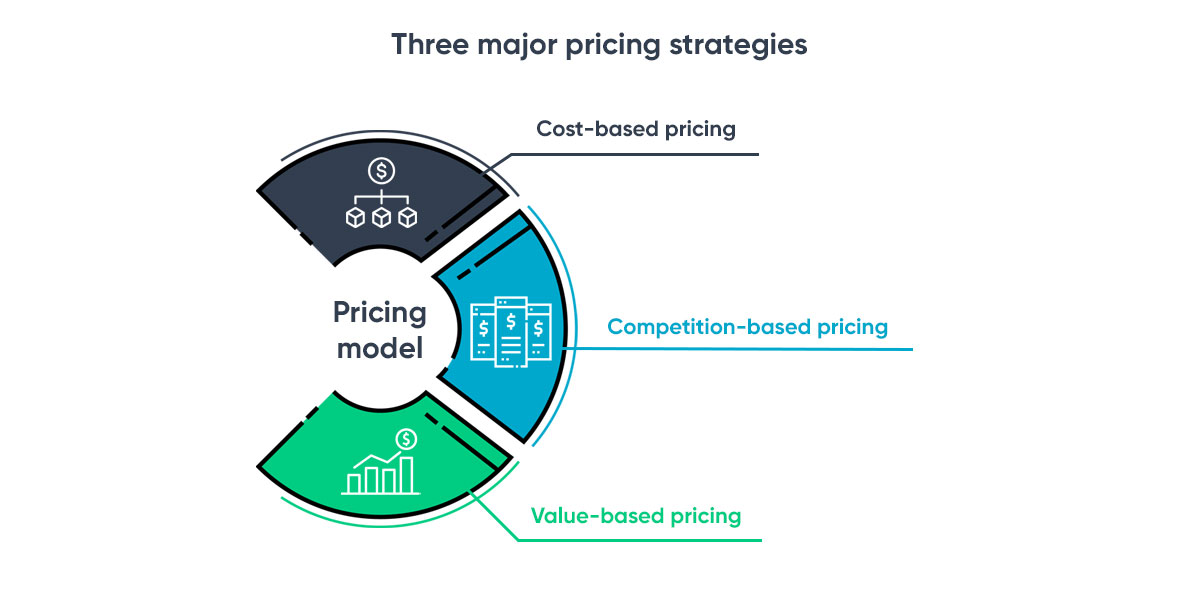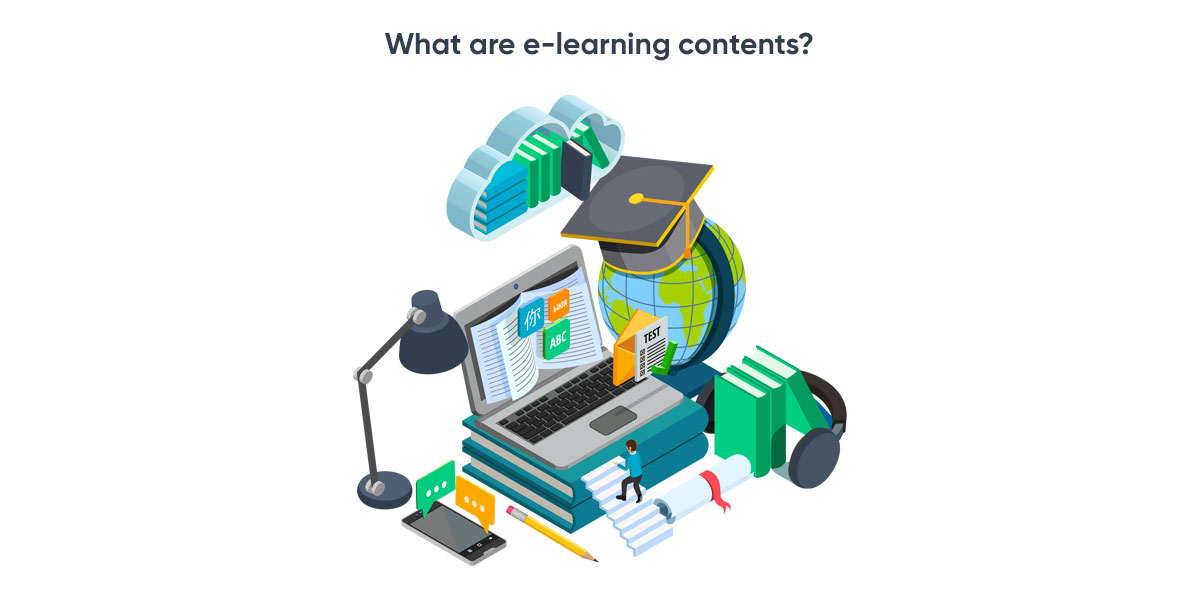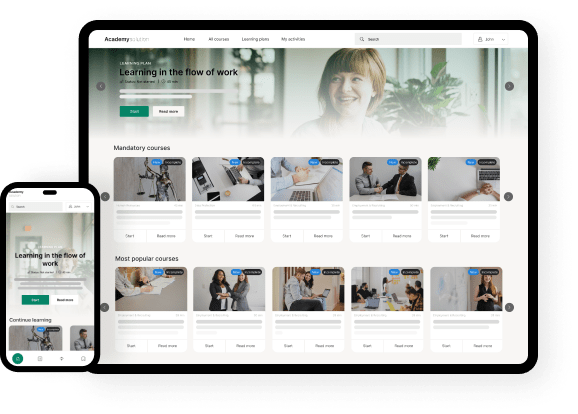If you run a consulting business, you know how difficult it can be to set the stage to enable and support scalability of your company. However, using an online academy to turn your service business into a product-based business can solve this problem.
If you’re considering taking your expertise from offline to online and joining the SaaS world there are a few things you should know in order to maximize your success.
In this guide, we’ll let you in on all the important aspects of running an online knowledge business. So, sit back and relax as we take you through the different pricing strategies, distribution choices, and content management opportunities you have with an online academy.
How to decide on a pricing strategy for your online academy
Online or offline business, finding the right pricing strategy is always crucial. And how you charge is just as important as how much you charge. Yet, figuring either out isn’t easy.
Different ways to set the price
The original way to charge is to just add an additional cost on top of how much it costs to provide your service. This is called cost-plus pricing but is almost never seen in the services realm. That is because if you want to increase your spend on a marketing channel or make a new hire, your costs are bound to continually increase, and it’s hard to tune your pricing proportionally along with it.
Competitor-based pricing is another way to get a ballpark figure of what your product should be priced. Yet, basing your pricing on another company’s strategy doesn’t give you a good understanding of which customer segment you’re selling to and how much they’re willing to pay for the value you offer. And without this knowledge, it’s terribly difficult to develop a foolproof product and pricing vision.
But then there’s the pricing strategy that almost every SaaS pricing connoisseur swears by: value-based pricing.
[Value-based pricing] could easily be called “Customer-Based Pricing” because that is effectively what it is. Instead of looking inwardly at your own company, or laterally towards your competitors, with value-based pricing you look outward.
Patrick Campbell of Price Intelligently
Keep your pricing simple and easy for customers to understand without them having to refresh their mathematical skills. Simply align your pricing with the value that your customer receives, and make sure to pick a value metric that scales with customers’ usage of your product. This should ensure that your pricing can and will follow when your business scales.

Our favorite pricing strategy
Of course, these aren’t the only pricing strategies that exist. There are dozens of pricing strategies that can help you set the right price for your audience and revenue goals.
If we were to mention just one more pricing strategy it should be the freemium pricing strategy. A favorite of ours – especially when you’re moving from offline to online business.
Freemium is coined by the words “free” and “premium”. It’s the first part of the word that lures in users. This strategy is simply built on the idea of attracting users, letting them try your product, and giving them enough reason to stay while at the same time leveraging your product’s viral nature to get the word out.
To know more about how you can make the freemium strategy work for your business click here.
We know how pricing can seem overwhelming. But it’s important to dedicate some time to this matter and explore all options before settling on a strategy.
How to create content for your online academy
An online academy is all about content. So, having a clear plan for content production and management is key to the success of your SaaS adventure.
Therefore, before investing in an online academy you should ask yourself these three questions:
- Who will be in charge of content creation?
- How much money can we set aside for content production and management in our budget?
- Where will we store our content?
Question 1: Content creation
The number one mistake we see our customers make is not being ready to make use of their academy immediately when they get it.
If they have content, it takes them a long time to upload it to their online academy. And if they don’t have any content readily available for uploading, it takes them a while to produce it.
Transforming your analog materials to digital content
If you have content, it’s maybe in the form of thick ring binders or power point presentations or maybe even CDs or DVDs. Regardless of the format, you simply must digitize it and upload it to your online academy. But make sure you have a plan, because otherwise the process will be cumbersome if not chaotic even.
Start with the materials that are easiest to digitize. That could be text-based courses. They don’t demand much finessing as you’ll just be typing in words or numbers. Next up are the materials that need a little more processing such as video or audio files. For this kind of materials, you need to look into more technical stuff like resolution, sizing, sound quality and maybe even subtitles. Lastly, you can focus on quizzes. These too demand a bit more attention since you’ll need to work out a point or grading system.

You of course can’t transform all your content at the same time, so plan accordingly. What is your most important or popular content? And what content don’t you use that often?
Planning is essential for a smooth transition.
Content creation in the long run
The sooner you deploy your academy, the quicker you’ll be able to grow your audience and scale your business. Yet, you not only need a starting plan. You also need to consider how you’ll deal with content creation in the long run.
To continuously have updated and relevant content for your academy you can in general take three different approaches:
- Create all content in-house
- Employ an external content creator
- Buy and utilize ready-to-sell content
With Cursum’s customizable e-learning platform, you can create content directly within your academy. Simply upload and organize all your learning content directly to our responsive course builder. Since you don’t need any third-party creator tools, all the above approaches are appropriate.
In-house content creation
The best content provides relevant and up-to-date information, and to produce this usually requires subject matter expertise. An in-house content creator might be an expert themselves, but if not, they always have access to domain experts within your company. This enables among other things more in-depth and high-quality content, and it also permits a quicker production time so that you can have a faster response time to changing content needs.
External content creation
An external content creator on the other hand is great if you don’t have the resources to employ an in-house content creator. When outsourcing content creation, you gain more flexibility. Depending on your needs you have the option to change content creators and exploit different talents. Some creators are amazing with video while others are champions within audio. Whatever field or industry you’re in, you’re likely to find a learning expert whose knowledge you can avail yourself of.
Ready-to-sell content
The last option is to buy and utilize ready-to-sell content from any outside source. Utilizing ready-made content holds some of the same benefits as working with an external content creator does. Yet, relying on already existing content ensures that you know what you get. For example, Fellowmind Denmark provides a Microsoft Office 365 course package either through their learning portal or for customers to implement and use via their private learning portal.
Regardless of the approach you choose, Cursum’s academy solution makes it easy for you (or your content creator) to build personalized course catalogues utilizing any file format including audio, video, quiz, and plain text. Furthermore, our multitude of add-on modules has been developed to make your course building more powerful. Use for example our Azure Media Services module to encode, store, and stream video and audio at scale. Or apply our Kudo Shop module to give your employees a place to spend their hard-earned kudo points. The possibilities are endless.
Question 2: Content budget
Before you make any decisions about content creation you of course must consider what your budget allows for.
Content production is usually not a one-time process. In most cases, content needs to be maintained and updated on a regular basis. It is therefore utmost important that you take into account the running costs related hereto when compiling your budget.
Also, note that the costs of content production and maintenance differ widely depending on whether you choose the DIY method or seek professional help.
It’s not only about finding an approach to content production that fits your wants and needs, but the approach should also fit your budget.
Question 3: Content storage
Finally, you should think about how you’ll store your content.
Seeing that you can create your content directly in our e-learning platform you in fact don’t need any third-party content creation or storage tools.
That is because Cursum doesn’t only provide a simple Learning Management System (LMS) but also offers a more advanced Learning Content Management System (LCMS).
As an example, one of our clients, the Norwegian Police, have decided to ditch all other tools and now solely use our platform for their content production and storage.
Yet, if you prefer to store your learning materials elsewhere that is also possible. For example, some businesses wish to use a third-party content storage solution for greater control. In that case, our system supports all common e-learning standards such as SCORM, xAPI, CMI, and LTI.
When it comes to e-learning standards, you’ll need to make a call on which one best supports the goals of you and your business. In order to make an informed choice, you should take into consideration things like delivery format, whether tracking is required and to what degree, and how the course will be consumed.
How to distribute your knowledge with an online academy
Great content is a waste if your audience doesn’t know it exists.
Distributing your content is a vital part – if not the most important part – of running your online academy.
Content distribution is the process of sharing, publishing, and promoting your content. It’s about how you deliver your content to your audience members for their consumption through different channels and media formats.
Since you move your business from offline to online with an online academy, you of course get more than one distribution channel to choose from.
With Cursum you can choose to use your online academy as your sole distribution channel. However, you can also choose one of the following distribution options or combine several to build a strategy that suits your needs:
- Create a white label custom app within Microsoft Teams
- Build a published app for Microsoft Teams and market it through Microsoft AppSource
- Have us develop your private app for IOS and Android
Regardless of the distribution strategy you choose, the process of distribution happens after you have created your content.
Yet, it’s important that you plan where and how you’ll be publishing your content before creating it. If not, your time and resources could easily go to waste.
Choosing the right distribution strategy
Digital technologies play a prominent role in shaping up and regulating the standards of everything we do.
Throughout the COVID-19 pandemic, communication and collaboration platforms such as Microsoft Teams, Zoom, and Google Meet gained much importance as organizations moved their activities to a virtual environment.
Working from home has not only popularized digital platforms of all sorts. The convenience of having everything you need only a click away has made many of us resort to digital opportunities whenever possible.
Therefore, putting knowledge at the fingertips of your users with an app isn’t such a bad idea.
Which app you need completely depends on who’ll be using it and for what purpose.
Below we’ll take you through the different options you have with Cursum.
A custom app within Microsoft Teams
At Cursum we’re determined to provide the best availability of and access to our powerful digital platform.
Being an Independent Software Vendor (ISV) partner of Microsoft, we’ve enabled our customers to easily create their own white-label app within Microsoft Teams.
If you’re targeting businesses who already utilize Microsoft Teams, a custom app within this communication and collaboration platform is a great distribution channel for you.
All you must do is create your own white label learning app in Microsoft Teams. You have multiple options for customizing the app’s interface, so you can make it fit your brand’s look and feel. Once you’ve created your app, you download it as a zip file and distribute it internally within any organization. All the organization must do is upload it to their Microsoft Teams Account and employees can log in with their single sign-on access code.
This distribution channel fosters a more intuitive and less disruptive learning experience. There’s no need for a secondary platform or software. And considering your target audience use Microsoft Teams already, they undoubtedly view this channel as a trusted and secure tool. Giving employees access to your expertise in the flow of their daily work makes learning and development an easy and integrated task.
A published app for Microsoft Teams
If you’re aiming for a broader target audience, creating a published app for Microsoft Team is a great alternative.
Unlike the custom app, a published app is publicly available for download in Microsoft Teams’ AppSource – the marketplace for apps made specifically for this platform.
Microsoft’s commercial marketplace contains more than 30,000 published apps and serves more than four million active shoppers every month. Today this marketplace is the world’s most comprehensive B2B commercial arena. This will not only introduce your product to more potential customers, but it will also give you access to joint go-to-market activities with Microsoft. All something that will enable you to establish more connections, get referrals, and potentially generate more leads.
A published app works as a centralized knowledge-sharing platform containing all your expertise. With the published app, you have all the same customization options as with the custom app. However, you can also display your own logo to create a stronger brand.
We’re of course here to assist you from pre-submission to store submission by helping you complete all the necessary steps and procedures to ensure a successful listing process.
One of the benefits of choosing the published app distribution method is that you can fully exploit the freemium pricing strategy. Giving your target audience a sneak peek of your product is a great way to do lead generation and find new sales channels supporting your online academy.
IOS and Android apps
If your target audience prefer to have an isolated point of access to your expertise, let us help you build your own app to use for distributing your learning materials.
We’ll handle the app development process from start to finish – you don’t have to lift a finger.
The app can be created exclusively for Apple App Store, Google Play, or both marketplaces. Furthermore, the app’s interface can be customized to fit your brand as well as it can display your business’ logo.
This distribution strategy is perfect if you’re for example catering to a target audience that aren’t stationed at their desk or computer all day such as many blue-collar workers. With an exclusive app containing all your expertise on their phone or tablet, they can use it whenever and wherever they want.
A dedicated app promotes one of the most accessible and flexible learning experiences.
What to do now
Now you know everything there is to know about establishing and running an online academy.
Moving your business from offline to online won’t only make it easier, cheaper, and faster for you to manage and distribute your expertise. With an online academy, it’ll also be easier for you to protect your business. That is because transforming your service to a product means you’ll be able to claim it as intellectual property.
Also, we shouldn’t forget that the global e-learning market is projected to reach $325 billion in 2025. That of course is of no surprise when you consider the billowing call for digital transformation seen across almost every industry the last couple of years.
Investing in your own online academy will not only tap right into this trend and give you a strong competitive edge. It will also futureproof your business.
So, whether you just want an online product to complement your offline business or you’re ready to go 100 % digital, feel confident that you’ve got the most flexible technology to support you with Cursum.
We believe that your expertise deserves only the best living conditions. If you do too, book a demo today.


